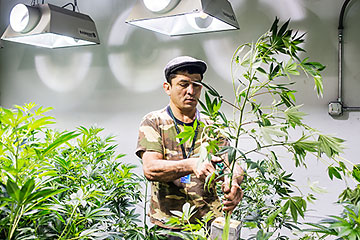
Colorado requires pot shops like Medicine Man togrow 70% of their product. Adults can buy up to 1 oz. at a time for recreational use.
(2 of 4)
Some already have. In July, a medical-marijuana-dispensary owner and a security guard were shot and killed during an apparent robbery in Bakersfield, Calif. In October 2012 the industry was shaken by the grisly tale of three people who allegedly kidnapped the owner of a lucrative dispensary in Orange County. According to court documents, the assailants zip-tied the victim, tortured him and drove him to a patch of desert where they believed he had buried large sums of money. When the kidnappers couldn't find it, they allegedly burned him with a blowtorch, cut off his penis and doused him with bleach before dumping him along the side of a road. (He survived.) "Marijuana dispensaries are full of cash," Melinda Haag, the U.S. attorney for Northern California, said in 2012. "They are at risk of being robbed, and many of them are."
When Colorado began assembling its retail pot market, the guiding principle was safety, says Barbara Brohl, the state's head cannabis regulator. The plan was meant to bring marijuana out of the shadows and into the stores, where inventory is tested and tracked. After 55% of voters approved a constitutional amendment to legalize recreational cannabis in November 2012, a task force created by Democratic governor John Hickenlooper scrambled to write rules for everything from packaging to advertising.
The state took steps to block underage use, cap purchases and deter people from driving while stoned. Regulators made stores grow 70% of the product they sell, an onerous requirement designed in part to limit supply, which might in turn prevent rogue dealers from amassing product and transporting it across state lines.
But one major issue was beyond the state's control. Federal law prevents banks from transacting with businesses connected to so-called Schedule I drugs. That means the array of companies based in the 20 states (plus the District of Columbia) that allow medical-marijuana sales cannot legally do business within the financial system.
Denied this access, dope merchants are forced to find ways around the restriction. Through "don't ask, don't tell" relationships with sympathetic bankers, some businesses obtain accounts under an owner's name or those of affiliated consultancies. At one point, as the number of medical-marijuana dispensaries in Denver grew to exceed the number of Starbucks, a single bank in Colorado Springs had an estimated 300 cannabis clients. But over time, hefty cash deposits trigger the scrutiny of compliance officers, who can shut the accounts. And the spotlight has only made banks more skittish.
